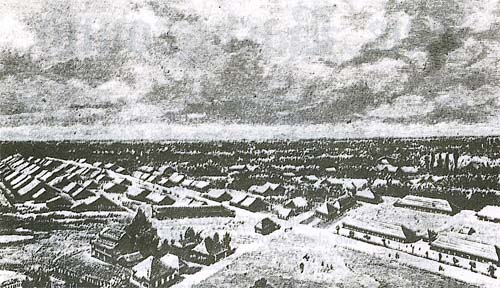Black gold from the kiln
Story by EDMUND NGO
edmundngo@thestar.com.my
Photos by LEW YONG KAN
Mist filled the air as water vapour gushed out of small holes of a brown large igloo called kilns where mangrove wood are ‘baked’.
As soon as the process is completed, large trunks become shining dark charcoals worth their weight in gold.
Devoid of water, these ‘black beauties’ are said to add the extra oomph in your tea or even barbeque.

Deft: A worker stripping the bark from a mangrove tree trunk before it is ‘baked’ in the oven to produce charcoal.
The uniqueness of the charcoal lies very much in the traditional production method and the Matang mangrove forest, which provides the raw material.
Khay Hor Holdings Sdn Bhd manager Chuah Chow Aun, 63, said people often thought charcoal was just burnt wood without value but in reality it was highly sought after in the earlier days and even now.
“Before gas cookers were around, the poor used rubber tree branches to cook their meals while the rich had abundant supply of charcoal, which showed their stature and wealth,” he said.
Chuah explained that the charcoal production process began with the cutting of mangrove tree trunks from the Matang forest reserve and bringing it back to the factory that is located next to a small canal in Kuala Sepetang.

Unique: A charcoal in gold case and wrapped with red ribbons is a token of good luck. The gift can also be used to absorb unpleasant smells in the vehicle.
“Every kiln will be allotted 2.2 hectares of mangrove tree trunks annually and if the factory finishes its allocation, it is not allowed to cut down trees from non-designated areas,” he said, adding that the Foresty Department constantly monitored their activities.
He said the workers would cut the trees into logs measuring 1.6m in length.
“They would do the work early in the morning and place the logs onto boats to be taken to the factory during high tide, through the canal,” he said.
Filled with saltwater, the bark is removed from the logs as soon as possible to prevent the barks from sticking to the log. Next, the logs are arranged on top of small rocks in huge kilns.
When stacked closely, the handmade kilns could contain up to 50 tonnes of logs at a time.
“The kilns, each costing up to RM16,000, are handmade using over 26,000 bricks,” he said, adding that each kiln could last up to 12 years.
“After the logs are stacked inside, the opening would be sealed with clay and a ‘big fire’ would be made and it would burn for up to 10 days” he said.
Chuah said the trick lies in ensuring the steady flame did not burn the wood but only dehydrated it.
“Experienced workers would know if the wood inside is burning just by its scent,” he said.
After 10 days, the flame would be reduced and continues to burn for another 14 days until the vapour completely dries up.
After a check by a supervisor, the flames would be put out and the opening of the kiln would be sealed again to allow the logs to cool for another eight days to produce the mangrove charcoal.
The charcoal are broken into smaller pieces, weighed and packed before being shipped to Japan, which is one of the countries which has a high demand for it.
“The Japanese believe it is healthier to use charcoal for cooking compared to gas.They enjoy the extra ‘oomph’ it gives to their tea and cooking, including providing heat for their saunas,” he said.
He said apart from cooking, the charcoal was also symbolic to the Chinese community, with the bride giving two long pieces of charcoal tied with a red cloth as a wedding gift, where it would be placed in the kitchen, near the stove.
“This serves as a blessing for the couple to have food to cook always, and apart from cultural importance, the charcoal is also useful in absorbing unpleasant smells,” he said.
The factories in Kuala Sepetang had been producing high-quality charcoal since the 1950s and thus draw countless numbers of local and foreign tourists.
Chuah often conducts tours around his factory for schoolchildren and even homestay tourists who consider the place a wonderful attraction.
“Many people think the charcoal industry has come to an end but on the contrary, it is flourishing.
“My greatest joy now is meeting new people and telling them about these wonderful ‘black gold’,” he said.


